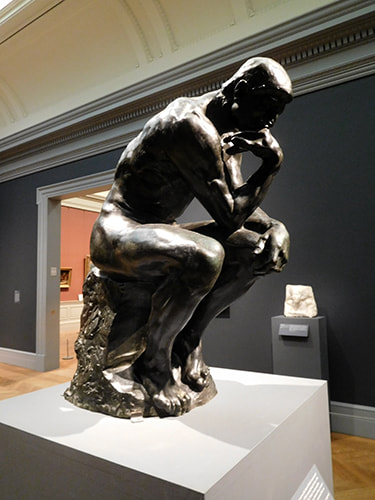 Rodin At The Met is a salute to the sculptor Auguste Rodin on the 100th anniversary of his death. It is an entirely fitting tribute as the then-young museum was a supporter of this artist during his lifetime to the extent of opening a gallery dedicated to his work in 1912. Rodin showed his appreciation by giving the Met additional works. This exhibit of some 50 works includes not only the works that the Metropolitan Museum of Art acquired during the artist's lifetime but also works that it has collected subsequently. Auguste Rodin was from a working class family that lived in Paris. He received his basic training in art at the Petit Ecole. However, he was refused admission to the prestigious Ecole des Beaux-Arts, the leading art academy in France. Although this forced Rodin onto a much more difficult road to success, he also avoided indoctrination into the lifeless Neo-classical style that was the trademark of that school. Instead, Rodin slowly built his own style along with his reputation, first as an apprentice to other artists and then on his own. One turning point was his visit to Italy in 1876 during which he was very impressed by the sculptures of Michelangelo. Even after he achieved fame, Rodin's style was not what people expected. There is story after story of how individuals and public authorities commissioned works only to be shocked by Rodin's final product. Those that were rejected are now recognized as some of the greatest works of 19th century art. Rodin found fame in the United States after some of his works were displayed at the 1893 Chicago World's Fair. Here again, some of his works were found so shocking that they were exhibited behind a curtain in an area that required special permission to enter. However, private collectors and museums were soon purchasing his works. The Met has casts of several of Rodin's best known pieces including The Thinker, the companion sculptures Adam and Eve, the Age of Bronze and a study for the Monument to Balzac. Rodin modeled his sculptures in clay. Plaster casts were then made to preserve the sculpture. From these, bronze casts were made or marble carved often by studio assistants. This explains why the same work can appear in multiple museums. There is a discernible difference between Rodin's bronzes and marbles. You can see the power of the sculptor's fingers working the underlying clay in the bronzes. The marbles tend to be less distinct, smoother and gauzier, almost dream-like. In either case, you can clearly see Rodin's works were a clear break from the allegorical figures and gods and goddess so popular at the time. While some have titles that relate back to mythology or the bible, these works are of real people with real emotion. A particularly fascinating part of this exhibit is Rodin's works on paper. In addition to sculpture, Rodin also did watercolors and drawings. Some of these were in preparation for sculptures but mostly they were another means of communication. It is said that Rodin would draw without removing the pen from the paper and without taking his eyes off the model. The results were images that border on abstraction and which are full of emotion. Along with Rodin's works, the Met has hung examples of works done by his friends. One such friend was Claude Monet who also was leading a revolution in art in 19th century France. The two artists held a joint exhibition in 1889. These contemporary works help to place Rodin's works in context |
AuthorRich Wagner is a writer, photographer and artist. Archives
November 2018
Categories
All
|
 RSS Feed
RSS Feed